Impact of the Wind Turbine on the Parameters of the Electricity Supply to an Agricultural Farm
Abstract
1. Introduction
2. Materials and Methods
- rotor diameter, 40.3 m,
- rotor swept area, 1275 m2,
- rpm, rated power, 36 rpm,
- rpm, initial, 18 rpm,
- type of generator, synchronous ring generator
- rated active power, 500 kW,
- rated apparent power, 510 kVA,
- rated power factor, 0.98
- nominal voltage, 440 V,
- rated current, 738 A,
- rated frequency, 50 Hz,
- cut-in wind speed, 3 m/s,
- nominal wind speed, 12 m/s,
- cut-out wind speed, 25 m/s,
- ENERCON AC/AC converter.
- where: Uh—RMS voltage of the h-th harmonic, U1—RMS voltage of the fundamental harmonic, h—order of the harmonic.
- The value of the total voltage distortion coefficient THDU (expressed as a percentage) can be described by the relation [45]:
3. Results and Discussion
4. Conclusions
Author Contributions
Funding
Institutional Review Board Statement
Informed Consent Statement
Data Availability Statement
Conflicts of Interest
References
- Wang, J.; Song, Y.; Liu, F.; Hou, R. Analysis and application of forecasting models in wind power integration: A review of multi-step-ahead wind speed forecasting models. Renew. Sustain. Energy Rev. 2016, 60, 960–981. [Google Scholar] [CrossRef]
- Herrería-Alonso, S.; Suárez-González, A.; Rodríguez-Pérez, M.; Rodríguez-Rubio, R.F.; López-García, C. Efficient wind speed forecasting for resource-constrained sensor devices. Sensors 2021, 21, 983. [Google Scholar] [CrossRef]
- Taleb, H.M.; Abu Hijleh, B. Optimizing the power generation of a wind farm in low wind speed regions. Sustainability 2021, 13, 5110. [Google Scholar] [CrossRef]
- Bokde, N.D.; Tranberg, B.; Andresen, G.B. Short-term CO2 emissions forecasting based on decomposition approaches and its impact on electricity market scheduling. Appl. Energy 2021, 281, 116061. [Google Scholar] [CrossRef]
- Bokde, N.; Tranberg, B.; Andresen, G.B. A graphical approach to carbon-efficient spot market scheduling for power-to-X applications. Energy Convers. Manag. 2020, 224, 113461. [Google Scholar] [CrossRef]
- García-Sánchez, T.; Mishra, A.K.; Hurtado-Pérez, E.; Puché-Panadero, R.; Fernández-Guillamón, A. A controller for optimum electrical power extraction from a small grid-interconnected wind turbine. Energies 2020, 13, 5809. [Google Scholar] [CrossRef]
- Luo, Z.; Sun, Z.; Ma, F.; Qin, Y.; Ma, S. Power optimization for wind turbines based on stacking model and pitch angle adjustment. Energies 2020, 13, 4158. [Google Scholar] [CrossRef]
- Peste, F.; Paula, A.; Da Silva, L.P.; Bernardino, J.; Pereira, P.; Mascarenhas, M.; Costa, H.; Vieira, J.; Bastos, C.; Fonseca, C.; et al. How to mitigate impacts of wind farms on bats? A review of potential conservation measures in the European context. Environ. Impact Assess. Rev. 2015, 51, 10–22. [Google Scholar] [CrossRef]
- Chen, Z.; Wang, X.; Kang, S. Effect of the coupled pitch-yaw motion on the unsteady aerodynamic performance and structural response of a floating offshore wind turbine. Processes 2021, 9, 290. [Google Scholar] [CrossRef]
- Energy Regulatory Office. Installed Capacity [MW], as at 31.12.2020. Available online: https://www.ure.gov.pl/pl/oze/potencjal-krajowy-oze/5753,Moc-zainstalowana-MW.html (accessed on 7 May 2021).
- Igliński, B.; Iglińska, A.; Koziński, G.; Skrzatek, M.; Buczkowski, R. Wind energy in Poland-history, current state, surveys, renewable energy sources Act, SWOT analysis. Renew. Sustain. Energy Rev. 2016, 64, 19–33. [Google Scholar] [CrossRef]
- PSE Capital Group. Available online: https://www.pse.pl/ (accessed on 20 April 2021).
- Wiśniewski, G. Determination of the Energy Potential Polish Regions in terms of Renewable Sources of Energy-Lessons for Regional Operational Programmes for the Period 2014-2020 Programming Evaluation; Ministry of Regional Development: Warsaw, Poland, 2011. [Google Scholar]
- Pietrzak, M.B.; Igliński, B.; Kujawski, W.; Iwański, P. Energy transition in Poland-assessment of the renewable energy sector. Energies 2021, 14, 2046. [Google Scholar] [CrossRef]
- Central Statistical Office, Renewable Energy in 2016. Available online: https://stat.gov.pl/obszary-tematyczne/srodowisko-energia/energia/energia-ze-zrodel-odnawialnych-w-2016-roku,3,11.html (accessed on 24 June 2021).
- Central Statistical Office, Renewable Energy in 2017. Available online: https://stat.gov.pl/obszary-tematyczne/srodowisko-energia/energia/energia-ze-zrodel-odnawialnych-w-2017-roku,10,1.html (accessed on 24 June 2021).
- Data from the Marshal’s Office of Podlaskie Voivodeship.
- Ministry of Climate and Environment. Energy Policy of Poland until 2024; Ministry of Climate and Environment: Warsaw, Poland, 2021.
- Eriksen, P.B.; Ackermann, T.; Abildgaard, H.; Smith, P.; Winter, W.; Garcia, J.R. System operation with high wind penetration. IEEE Power Energy Mag. 2005, 3, 65–74. [Google Scholar] [CrossRef]
- Magdy, G.; Shabib, G.; Elbaset, A.A.; Mitani, Y. A Novel coordination scheme of virtual inertia control and digital protection for microgrid dynamic security considering high renewable energy penetration. IET Renew. Power Gener. 2019, 13, 462–474. [Google Scholar] [CrossRef]
- Blaabjerg, F.; Yang, Y.; Yang, D.; Wang, X. Distributed power-generation systems and protection. Proc. IEEE 2017, 105, 1311–1331. [Google Scholar] [CrossRef]
- Kundur, P. Definition and classification of power system stability IEEE/CIGRE joint task force on stability terms and definitions. IEEE Trans. Power Syst. 2004, 19, 1387–1401. [Google Scholar] [CrossRef]
- Zhou, M.; Zhai, J.; Li, G.; Ren, J. Distributed dispatch approach for bulk AC/DC hybrid systems with high wind power penetration. IEEE Trans. Power Syst. 2018, 33, 3325–3336. [Google Scholar] [CrossRef]
- Blaabjerg, F.; Teodorescu, R.; Liserre, M.; Timbus, A.V. Overview of control and grid synchronization for distributed power generation systems. IEEE Trans. Ind. Electron. 2006, 53, 1398–1409. [Google Scholar] [CrossRef]
- Oliveira, W.D.; Vieira, J.P.; Bezerra, U.H.; Martins, D.A.; Rodrigues, B.D.G. Power system security assessment for multiple contingencies using multiway decision tree. Electr. Power Syst. Res. 2017, 148, 264–272. [Google Scholar] [CrossRef]
- Ebrahimzadeh, E.; Blaabjerg, F.; Wang, X.; Bak, C.L.; Lund, T.; Andersen, G.K.; Suárez, C.G.; Berg, J.J. Small Signal Modeling of Wind Farms. In Proceedings of the 2017 IEEE Energy Conversion Congress and Exposition (ECCE), Cincinnati, OH, USA, 1–5 October 2017; pp. 3710–3716. [Google Scholar] [CrossRef]
- Shakerighadi, B.; Ebrahimzadeh, E.; Blaabjerg, F.; Leth Bak, C. Large-signal stability modeling for the grid-connected VSC based on the Lyapunov method. Energies 2018, 11, 2533. [Google Scholar] [CrossRef]
- Yan, R.; Saha, T.K. Frequency response estimation method for high wind penetration considering wind turbine frequency support functions. IET Renew. Power Gener. 2015, 9, 775–782. [Google Scholar] [CrossRef]
- Magdy, G.; Shabib, G.; Elbaset, A.A.; Kerdphol, T.; Qudaih, Y.; Bevrani, H.; Mitani, Y. A novel design of decentralized lfc to enhance frequency stability of Egypt power system including wind farms. Int. J. Energy Convers. 2018, 6, 17–29. [Google Scholar] [CrossRef][Green Version]
- Gonzalez-longatt, F.; Chikuni, E.; Rashayi, E. Effects of the Synthesis Inertia from Wind Power on the Total System Inertia after a Frequency Distrurbance. In Proceedings of the 2013 IEEE International Conference on Industrial Technology (ICIT), Cape Town, South Africa, 25–28 February 2013; pp. 826–832. [Google Scholar]
- Zhang, L.; Harnefors, L.; Nee, H.P. Power-synchronization control of grid-connected voltage-source converters. IEEE Trans. Power Syst. 2010, 25, 809–820. [Google Scholar] [CrossRef]
- Hu, Q.; Fu, L.; Ma, F.; Ji, F. Large signal synchronizing instability of PLL-based VSC connected to weak AC grid. IEEE Trans. Power Syst. 2019, 34, 3220–3229. [Google Scholar] [CrossRef]
- Renedo, J.; Garcı, A.; Rouco, L. Active power control strategies for transient stability enhancement of AC/DC grids with VSC-HVDC multi-terminal systems. IEEE Trans. Power Syst. 2016, 31, 4595–4604. [Google Scholar] [CrossRef]
- Lu, Y.; Tomsovic, K. Wide area hierarchical voltage control to improve security margin for systems with high wind penetration. IEEE Trans. Power Syst. 2018, 33, 6218–6228. [Google Scholar] [CrossRef]
- Arava, V.N.; Vanfretti, L. Analyzing the static security functions of a power system dynamic security assessment toolbox. Int. J. Electr. Power Energy Syst. 2018, 101, 323–330. [Google Scholar] [CrossRef]
- Sanchez, S.; Garces, A.; Bergna-Diaz, G.; Tedeschi, E. Dynamics and stability of meshed multiterminal hvdc networks. IEEE Trans. Power Syst. 2018, 34, 1824–1833. [Google Scholar] [CrossRef]
- Suproniuk, M.; Skibko, Z.; Stachno, A. Diagnostics of selected parameters of electricity produced in wind power plants. Electrotech. Rev. 2019, 11, 133–135. [Google Scholar] [CrossRef]
- Shakerighadi, B.; Peyghami, S.; Ebrahimzadeh, E.; Blaabjerg, F.; Bak, C.L. Security Analysis of Power Electronic-based Power Systems. In Proceedings of the IECON 2019-45th Annual Conference of the IEEE Industrial Electronics Society, Lisbon, Portugal, 14–17 October 2019; Volume 1, pp. 4933–4937. [Google Scholar] [CrossRef]
- Bahrami, S.; Amini, M.H.; Shafie-Khah, M.; Catalao, J.P. A decentralized renewable generation management and demand response in power distribution networks. IEEE Trans. Sustain. Energy 2018, 9, 1783–1797. [Google Scholar] [CrossRef]
- Quiroga, G.A.; Kagan, H.; Amasifen, J.C.C.; Almeida, C.F.M.; Kagan, N.; Vicentini, E. Study of the Distributed Generation Impact on Distributed Networks, Focused on Quality of Power. In Proceedings of the 2016 17th International Conference on Harmonics and Quality of Power (ICHQP), Belo Horizonte, Brazil, 16–19 October 2016; pp. 855–860. [Google Scholar] [CrossRef]
- Kroposki, B.; Johnson, B.; Zhang, Y.; Gevorgian, V.; Denholm, P.; Hodge, B.-M.; Hannegan, B. Operating electric power systems with extremely high levels of variable renewable energy. IEEE Power Energy Mag. 2017, 15, 61–73. [Google Scholar] [CrossRef]
- Distribution Grid Operation and Maintenance Manual; PGE Dystrybucja S.A., Lublin: Lublin, Poland, 2013; (as amended).
- Regulation of the Minister of Economy of 4 May 2007 on Detailed Conditions for the Operation of the Power System—Journal of Laws No. 93, Item 623 of 2007. Available online: http://isap.sejm.gov.pl/isap.nsf/DocDetails.xsp?id=wdu20070930623 (accessed on 24 June 2021).
- PN-EN 50160: 2010 Parameters of the Supply Voltage in Public Distribution Networks. Available online: https://sklep.pkn.pl/pn-en-50160-2010p.html (accessed on 24 June 2021).
- Hołdyński, G.; Skibko, Z. Analysis of Deformations of Currents and Voltages in MV Field Power Grids. Przegląd Elektrotechniczny Nr. 7, July 2011 r. str. 130–135. Available online: https://sigma-not.pl/publikacja-60808-analiza-odkszta%C5%82ce%C5%84-prad%C3%B3w-i-napi%C4%99%C4%87-w-terenowych-sieciach-elektroenergetycznych-%C5%9Bredniego-napi%C4%99cia-przeglad-elektrotechniczny-2011-7.html (accessed on 24 June 2021).
- Commission Regulation (EU) 2016/631 of 14 April 2016 Establishing a Network Code, Concerning Requirements for the Connection of Generating Units to the Network. Available online: https://eur-lex.europa.eu/legal-content/PL/TXT/PDF/?uri=CELEX:32016R0631&from=CS (accessed on 24 June 2021).
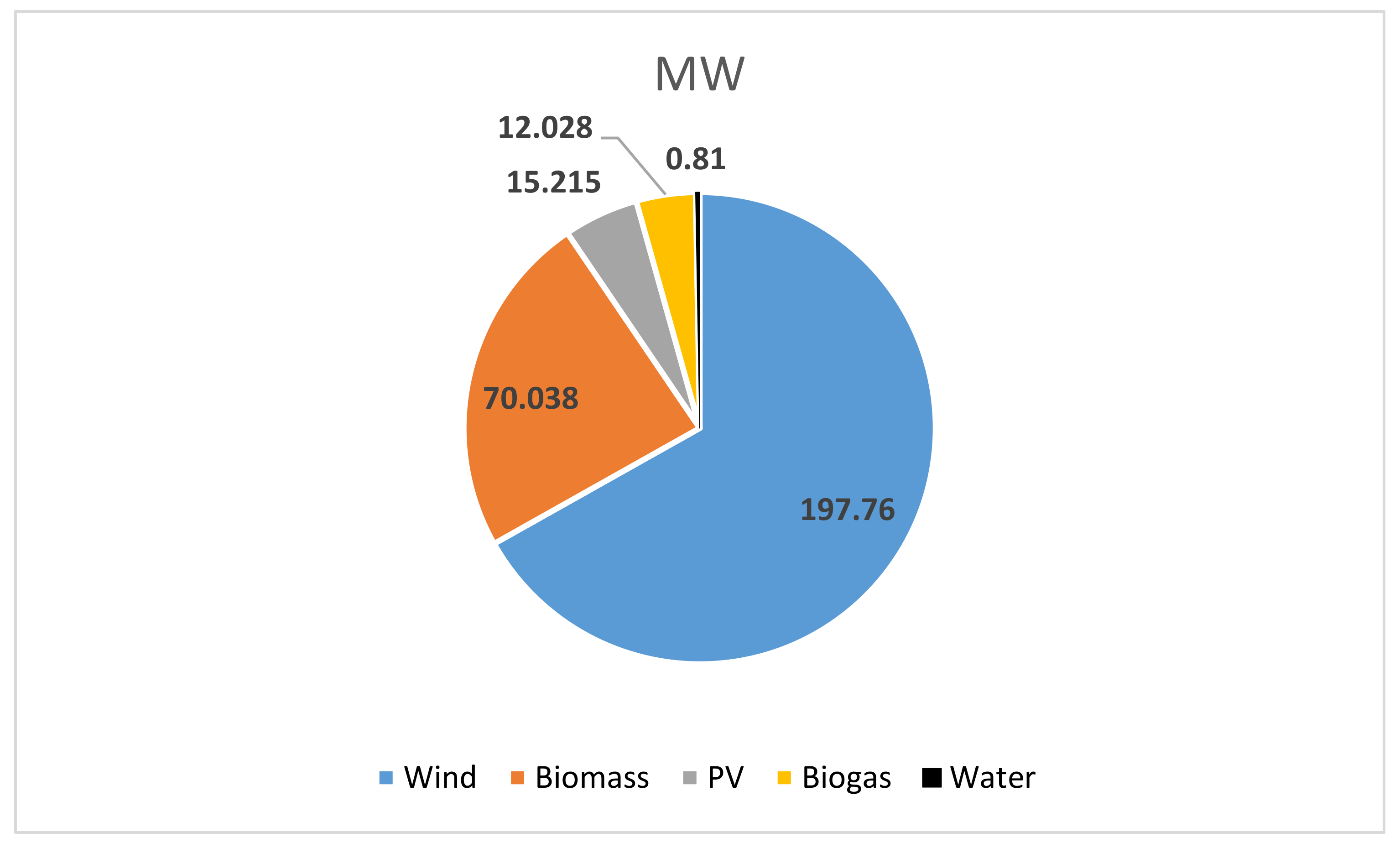

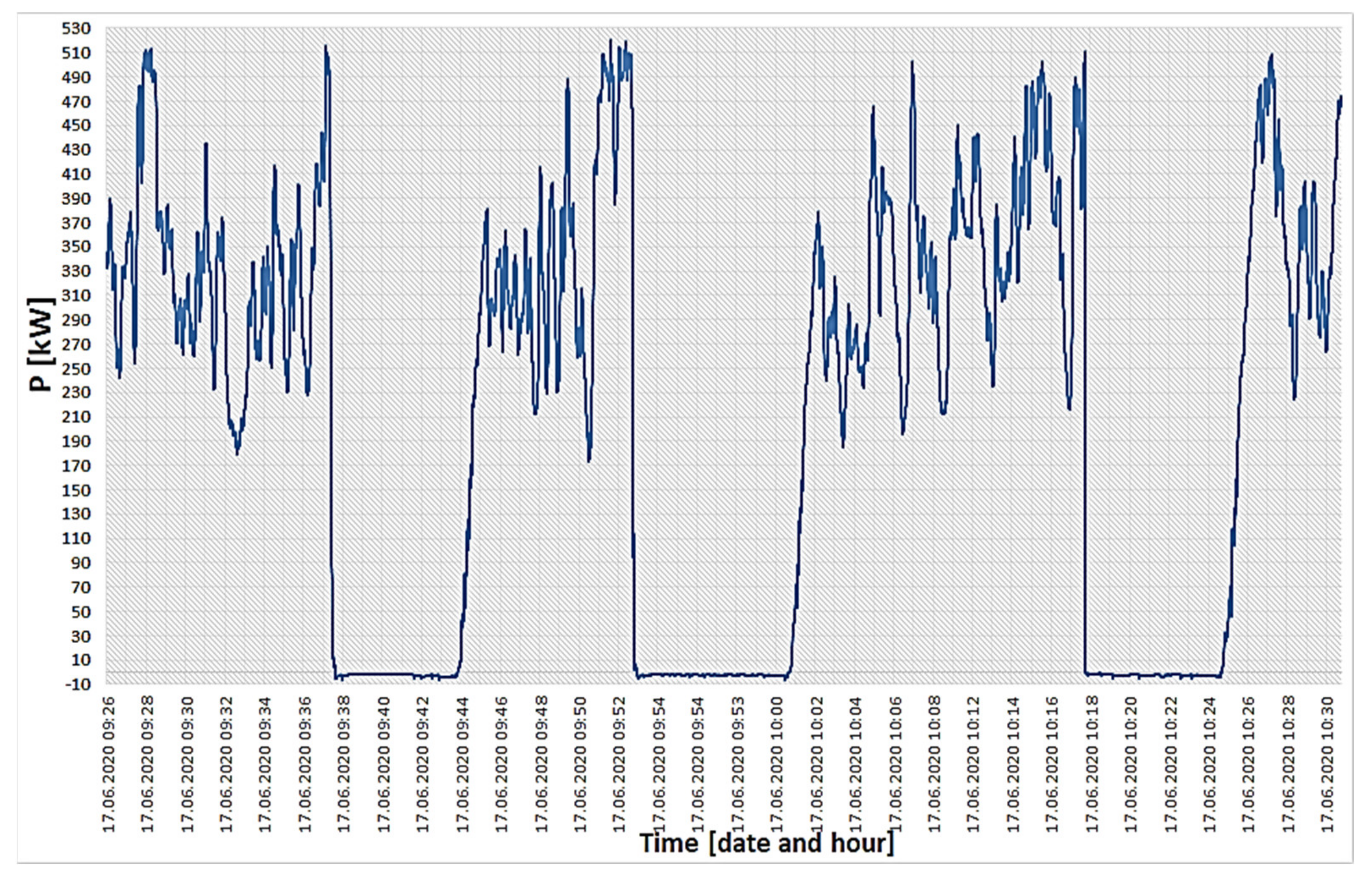
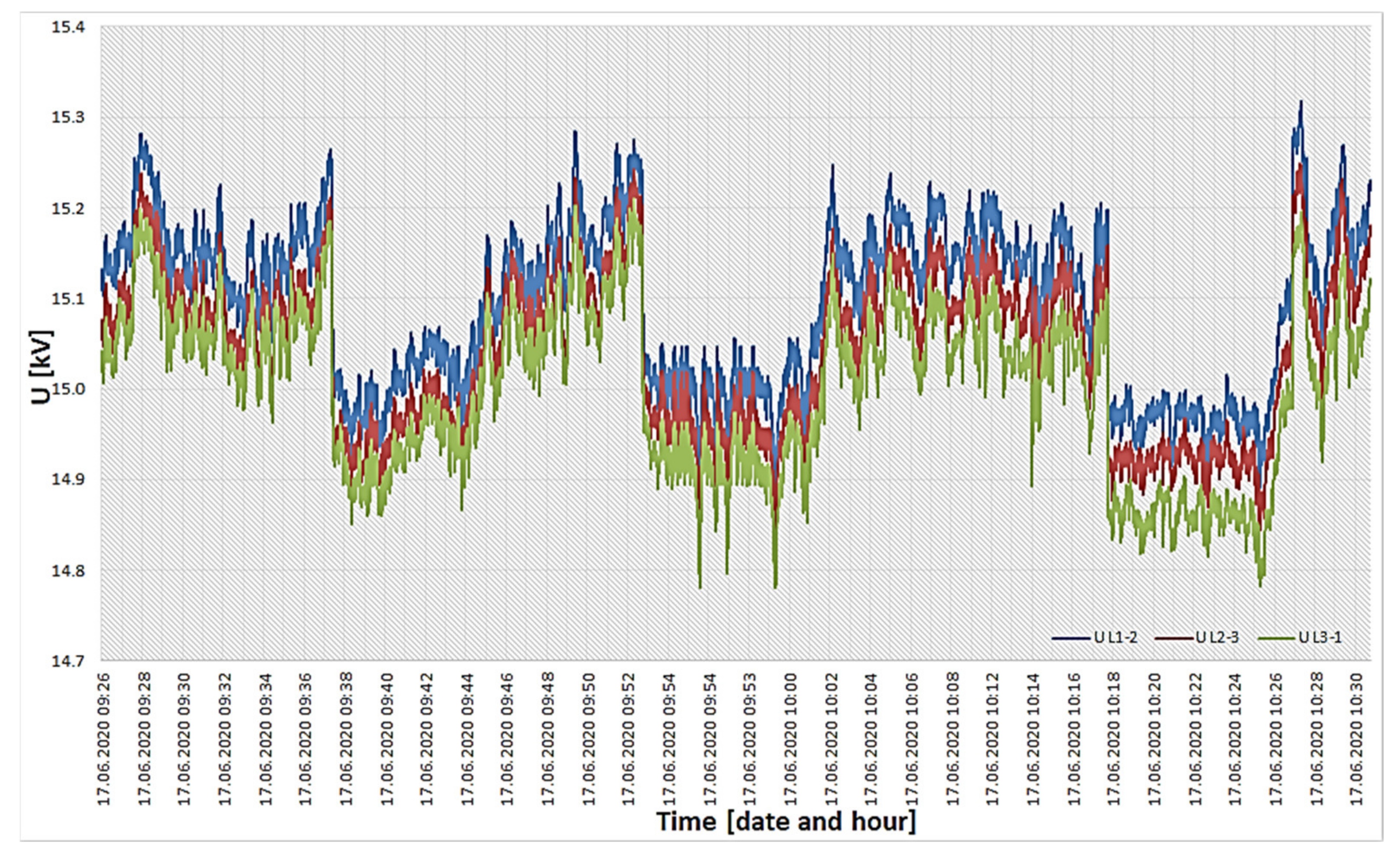

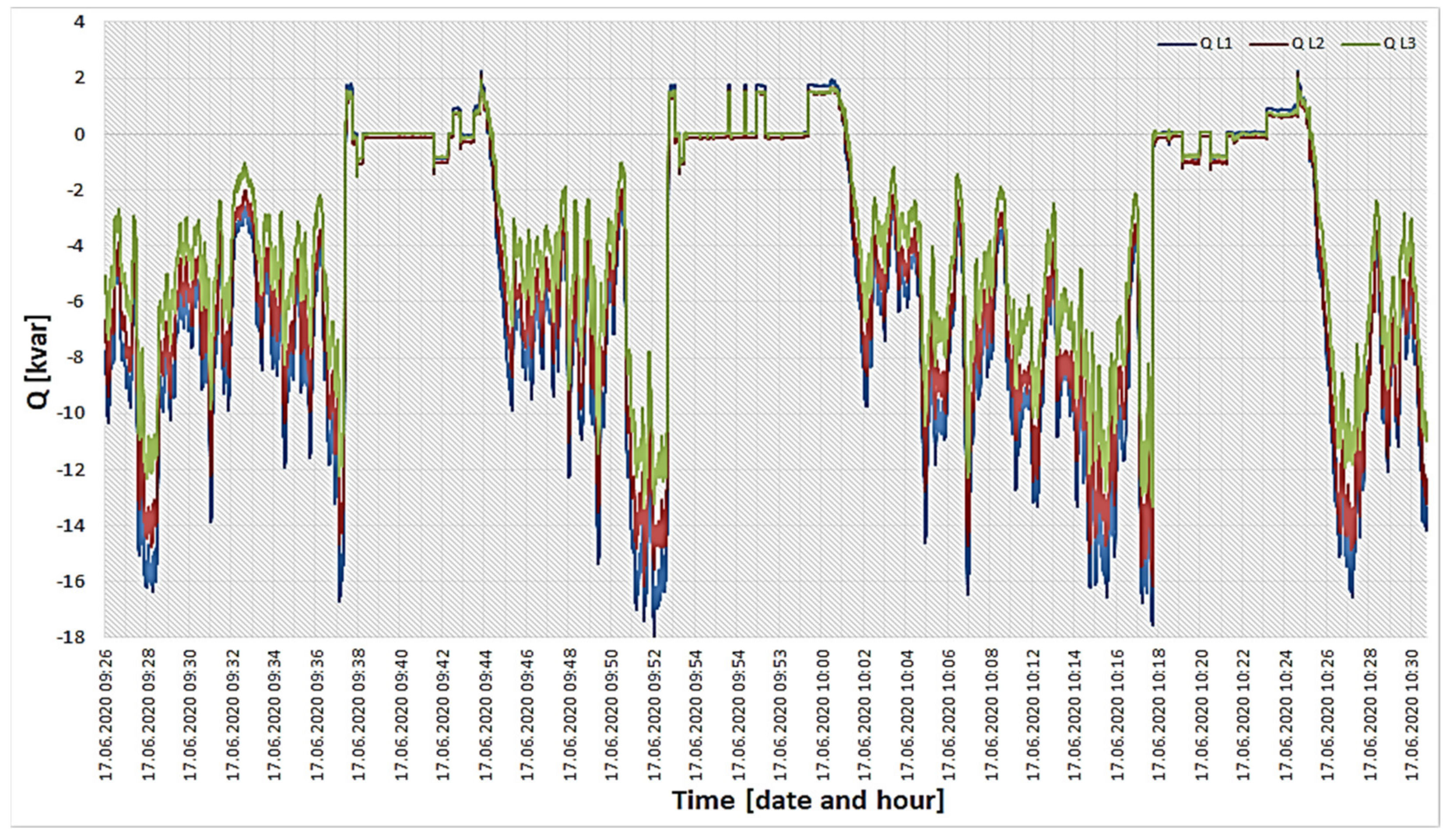


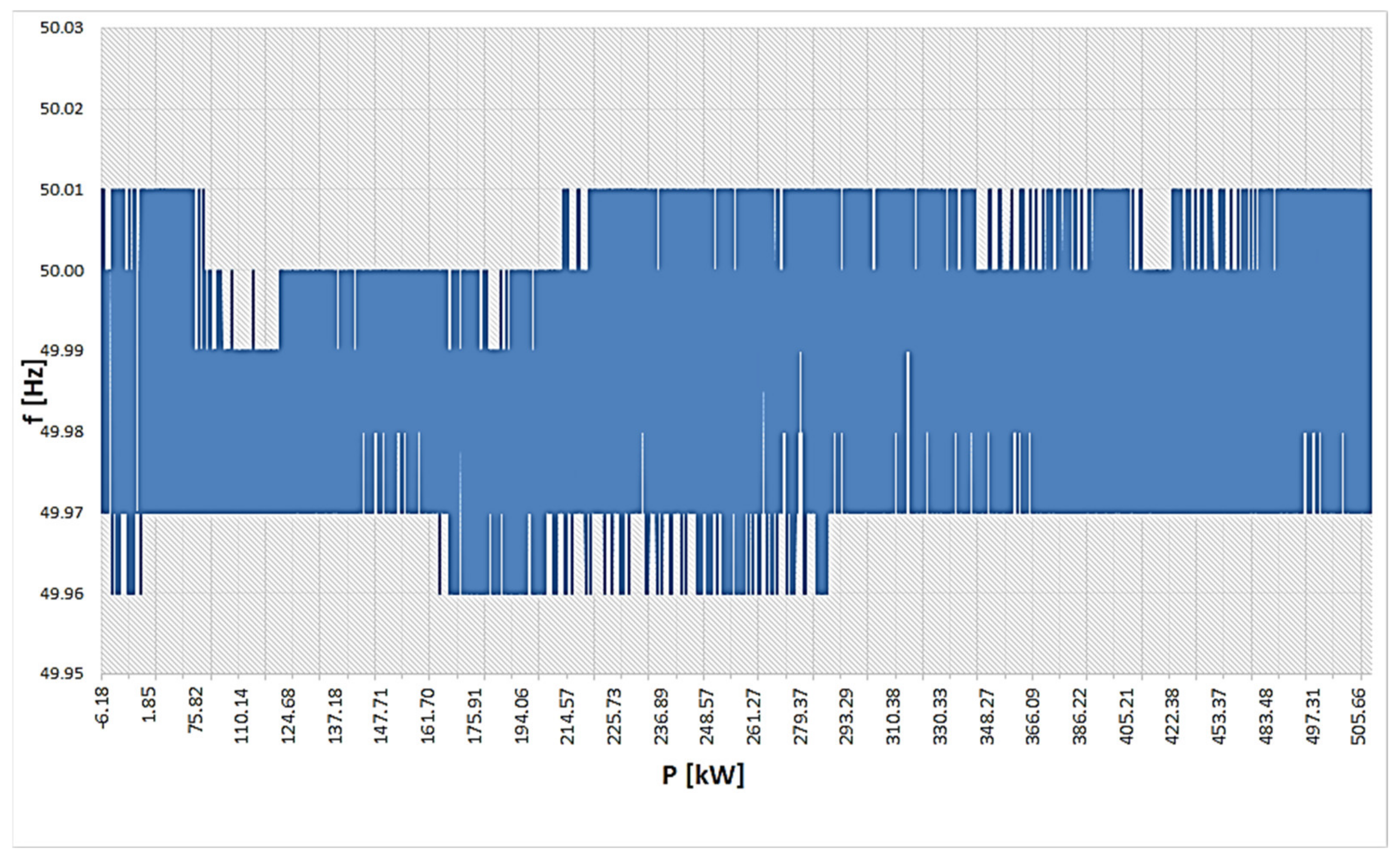

| Measured Value | Voltage | ||
|---|---|---|---|
| Phase L1-2 | Phase L2-3 | Phase L3-1 | |
| Voltage Values at the Disconnected Wind Power Plant | |||
| [kV] | [kV] | [kV] | |
| Average | 15.013 | 14.972 | 14.932 |
| Minimum | 14.985 | 14.945 | 14.911 |
| Maximum | 15.037 | 14.997 | 14.963 |
| Voltage values during wind turbine operation | |||
| [kV] | [kV] | [kV] | |
| Average | 15.243 | 15.207 | 15.174 |
| Minimum | 15.204 | 15.169 | 15.137 |
| Maximum | 15.275 | 15.243 | 15.210 |
| Voltage variations due to switching on/off of the wind power plant | |||
| [%] | [%] | [%] | |
| Average | 1.508 | 1.549 | 1.592 |
| Minimum | 1.098 | 1.134 | 1.150 |
| Maximum | 1.899 | 1.955 | 1.966 |
| Recorded Value | THDuL1 | THDuL2 | THDuL3 |
|---|---|---|---|
| [%] | [%] | [%] | |
| The average value of the total voltage distortion factor during standstill of a wind power plant | 2.021 | 2.031 | 2.068 |
| The average value of the total voltage distortion factor during wind turbine operation | 1.973 | 2.032 | 2.050 |
| The average value of the increase of the total voltage distortion factor caused by the operation of the wind power plant | -0.048 | 0.001 | -0.018 |
| Government Harmonic | No Wind Power Plant | Operation of a Wind Power Plant | Voltage Harmonic Gain Caused by the Operation of a Wind Power Plant | ||||||
|---|---|---|---|---|---|---|---|---|---|
| L1 | L2 | L3 | L1 | L2 | L3 | L1 | L2 | L3 | |
| [%] | [%] | [%] | [%] | [%] | [%] | [%] | [%] | [%] | |
| 1 | 2 | 3 | 4 | 5 | 6 | 7 | 8 | 9 | 10 |
| 2 | 0.020 | 0.019 | 0.014 | 0.014 | 0.015 | 0.013 | −0.0057 | −0.0038 | −0.0006 |
| 3 | 0.255 | 0.360 | 0.429 | 0.136 | 0.149 | 0.190 | −0.1183 | −0.2105 | −0.2395 |
| 4 | 0.016 | 0.007 | 0.021 | 0.013 | 0.013 | 0.025 | −0.0026 | 0.0062 | 0.0036 |
| 5 | 1.977 | 1.960 | 1.988 | 1.935 | 2.001 | 2.006 | −0.0422 | 0.0410 | 0.0172 |
| 6 | 0.012 | 0.008 | 0.010 | 0.011 | 0.012 | 0.014 | −0.0012 | 0.0042 | 0.0044 |
| 7 | 0.285 | 0.312 | 0.321 | 0.154 | 0.160 | 0.155 | −0.1308 | −0.1528 | −0.1669 |
| 8 | 0.003 | 0.005 | 0.004 | 0.006 | 0.007 | 0.006 | 0.0024 | 0.0024 | 0.0021 |
| 9 | 0.016 | 0.013 | 0.023 | 0.007 | 0.012 | 0.008 | −0.0088 | −0.0005 | −0.0153 |
| 10 | 0.002 | 0.002 | 0.002 | 0.006 | 0.006 | 0.006 | 0.0038 | 0.0036 | 0.0032 |
| 11 | 0.064 | 0.064 | 0.094 | 0.097 | 0.109 | 0.133 | 0.0323 | 0.0458 | 0.0392 |
| 12 | 0.003 | 0.004 | 0.002 | 0.008 | 0.008 | 0.008 | 0.0059 | 0.0042 | 0.0055 |
| 13 | 0.064 | 0.092 | 0.089 | 0.030 | 0.038 | 0.030 | −0.0343 | −0.0536 | −0.0595 |
| 14 | 0.002 | 0.002 | 0.002 | 0.009 | 0.010 | 0.010 | 0.0066 | 0.0073 | 0.0081 |
| 15 | 0.020 | 0.019 | 0.007 | 0.026 | 0.020 | 0.013 | 0.0059 | 0.0010 | 0.0062 |
| 16 | 0.003 | 0.003 | 0.002 | 0.009 | 0.010 | 0.010 | 0.0066 | 0.0075 | 0.0071 |
| 17 | 0.052 | 0.037 | 0.043 | 0.044 | 0.044 | 0.046 | −0.0080 | 0.0070 | 0.0033 |
| 18 | 0.002 | 0.002 | 0.001 | 0.010 | 0.009 | 0.010 | 0.0085 | 0.0071 | 0.0083 |
| 19 | 0.010 | 0.010 | 0.011 | 0.030 | 0.020 | 0.022 | 0.0205 | 0.0100 | 0.0107 |
| 20 | 0.002 | 0.002 | 0.002 | 0.013 | 0.012 | 0.013 | 0.0111 | 0.0099 | 0.0118 |
| 21 | 0.005 | 0.011 | 0.011 | 0.018 | 0.017 | 0.019 | 0.0121 | 0.0059 | 0.0082 |
| 22 | 0.003 | 0.003 | 0.003 | 0.015 | 0.015 | 0.016 | 0.0124 | 0.0119 | 0.0131 |
| 23 | 0.018 | 0.015 | 0.014 | 0.035 | 0.036 | 0.029 | 0.0177 | 0.0210 | 0.0144 |
| 24 | 0.006 | 0.006 | 0.007 | 0.020 | 0.018 | 0.020 | 0.0136 | 0.0121 | 0.0136 |
| 25 | 0.015 | 0.018 | 0.023 | 0.020 | 0.023 | 0.020 | 0.0059 | 0.0044 | −0.0024 |
| 26 | 0.003 | 0.003 | 0.003 | 0.023 | 0.023 | 0.022 | 0.0201 | 0.0202 | 0.0192 |
| 27 | 0.008 | 0.014 | 0.012 | 0.028 | 0.029 | 0.026 | 0.0195 | 0.0151 | 0.0139 |
| 28 | 0.008 | 0.008 | 0.008 | 0.030 | 0.029 | 0.028 | 0.0220 | 0.0204 | 0.0204 |
| 29 | 0.010 | 0.012 | 0.011 | 0.040 | 0.040 | 0.036 | 0.0305 | 0.0277 | 0.0254 |
| 30 | 0.005 | 0.004 | 0.005 | 0.034 | 0.033 | 0.033 | 0.0298 | 0.0283 | 0.0288 |
| 31 | 0.014 | 0.017 | 0.016 | 0.038 | 0.034 | 0.035 | 0.0243 | 0.0169 | 0.0188 |
| 32 | 0.005 | 0.005 | 0.006 | 0.041 | 0.040 | 0.041 | 0.0360 | 0.0344 | 0.0347 |
| 33 | 0.008 | 0.010 | 0.011 | 0.049 | 0.044 | 0.041 | 0.0404 | 0.0345 | 0.0294 |
| 34 | 0.007 | 0.006 | 0.006 | 0.053 | 0.052 | 0.048 | 0.0457 | 0.0462 | 0.0422 |
| 35 | 0.012 | 0.012 | 0.012 | 0.063 | 0.060 | 0.059 | 0.0507 | 0.0475 | 0.0473 |
| 36 | 0.008 | 0.007 | 0.007 | 0.068 | 0.067 | 0.060 | 0.0605 | 0.0595 | 0.0534 |
| 37 | 0.013 | 0.014 | 0.018 | 0.076 | 0.061 | 0.067 | 0.0638 | 0.0466 | 0.0490 |
| 38 | 0.009 | 0.008 | 0.009 | 0.074 | 0.070 | 0.071 | 0.0652 | 0.0622 | 0.0624 |
| 39 | 0.015 | 0.013 | 0.016 | 0.074 | 0.073 | 0.073 | 0.0589 | 0.0607 | 0.0577 |
| 40 | 0.010 | 0.009 | 0.009 | 0.067 | 0.078 | 0.072 | 0.0567 | 0.0695 | 0.0628 |
| 41 | 0.016 | 0.015 | 0.012 | 0.082 | 0.091 | 0.094 | 0.0664 | 0.0767 | 0.0819 |
| 42 | 0.008 | 0.008 | 0.009 | 0.062 | 0.075 | 0.074 | 0.0538 | 0.0670 | 0.0657 |
| 43 | 0.014 | 0.017 | 0.022 | 0.061 | 0.068 | 0.077 | 0.0469 | 0.0506 | 0.0548 |
| 44 | 0.007 | 0.007 | 0.008 | 0.057 | 0.064 | 0.063 | 0.0502 | 0.0567 | 0.0554 |
| 45 | 0.012 | 0.008 | 0.011 | 0.058 | 0.067 | 0.062 | 0.0465 | 0.0591 | 0.0512 |
| 46 | 0.007 | 0.007 | 0.007 | 0.061 | 0.066 | 0.058 | 0.0535 | 0.0591 | 0.0507 |
| 47 | 0.010 | 0.010 | 0.009 | 0.065 | 0.070 | 0.065 | 0.0550 | 0.0600 | 0.0562 |
| 48 | 0.006 | 0.006 | 0.006 | 0.061 | 0.063 | 0.055 | 0.0548 | 0.0569 | 0.0489 |
| 49 | 0.010 | 0.010 | 0.010 | 0.060 | 0.061 | 0.058 | 0.0495 | 0.0514 | 0.0473 |
| 50 | 0.006 | 0.007 | 0.007 | 0.057 | 0.060 | 0.053 | 0.0504 | 0.0530 | 0.0457 |
| Permissible Voltage Harmonics | |
|---|---|
| U2 ≤ 2% | U13 ≤ 3% |
| U3 ≤ 5% | U15 ≤ 0.5% |
| U4 ≤ 1% | U17 ≤ 2% |
| U5 ≤ 6% | U19 ≤ 1.5% |
| U7 ≤ 5% | U21 ≤ 0.5% |
| U9 ≤ 1.5% | U23 ≤ 1.5% |
| U11 ≤ 3.5% | U25 ≤ 1.5% |
| Even U6...24 ≤ 0.5% | |
| Parameter | Required Values in MV Networks | Values Obtained from Tests on MV Networks | Requirements Met? YES /NO |
|---|---|---|---|
| Value of voltage variation at the connection point during switching operations | ≤2.5% | max 1.966% (Table 1) | YES |
| Individual harmonic content | rise of single harmonics of the voltage 1.5% | max 0.0819% (Table 3) | YES |
| The value of the voltage distortion factor THD | increase THDU 4% | max 0.001% (Table 2) | YES |
Publisher’s Note: MDPI stays neutral with regard to jurisdictional claims in published maps and institutional affiliations. |
© 2021 by the authors. Licensee MDPI, Basel, Switzerland. This article is an open access article distributed under the terms and conditions of the Creative Commons Attribution (CC BY) license (https://creativecommons.org/licenses/by/4.0/).
Share and Cite
Skibko, Z.; Tymińska, M.; Romaniuk, W.; Borusiewicz, A. Impact of the Wind Turbine on the Parameters of the Electricity Supply to an Agricultural Farm. Sustainability 2021, 13, 7279. https://doi.org/10.3390/su13137279
Skibko Z, Tymińska M, Romaniuk W, Borusiewicz A. Impact of the Wind Turbine on the Parameters of the Electricity Supply to an Agricultural Farm. Sustainability. 2021; 13(13):7279. https://doi.org/10.3390/su13137279
Chicago/Turabian StyleSkibko, Zbigniew, Magdalena Tymińska, Wacław Romaniuk, and Andrzej Borusiewicz. 2021. "Impact of the Wind Turbine on the Parameters of the Electricity Supply to an Agricultural Farm" Sustainability 13, no. 13: 7279. https://doi.org/10.3390/su13137279
APA StyleSkibko, Z., Tymińska, M., Romaniuk, W., & Borusiewicz, A. (2021). Impact of the Wind Turbine on the Parameters of the Electricity Supply to an Agricultural Farm. Sustainability, 13(13), 7279. https://doi.org/10.3390/su13137279









